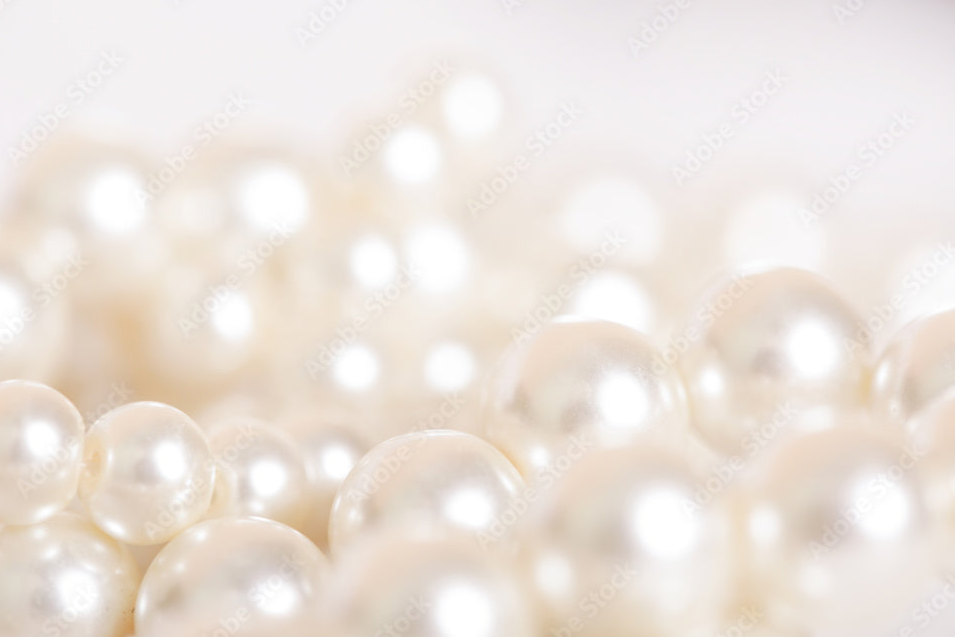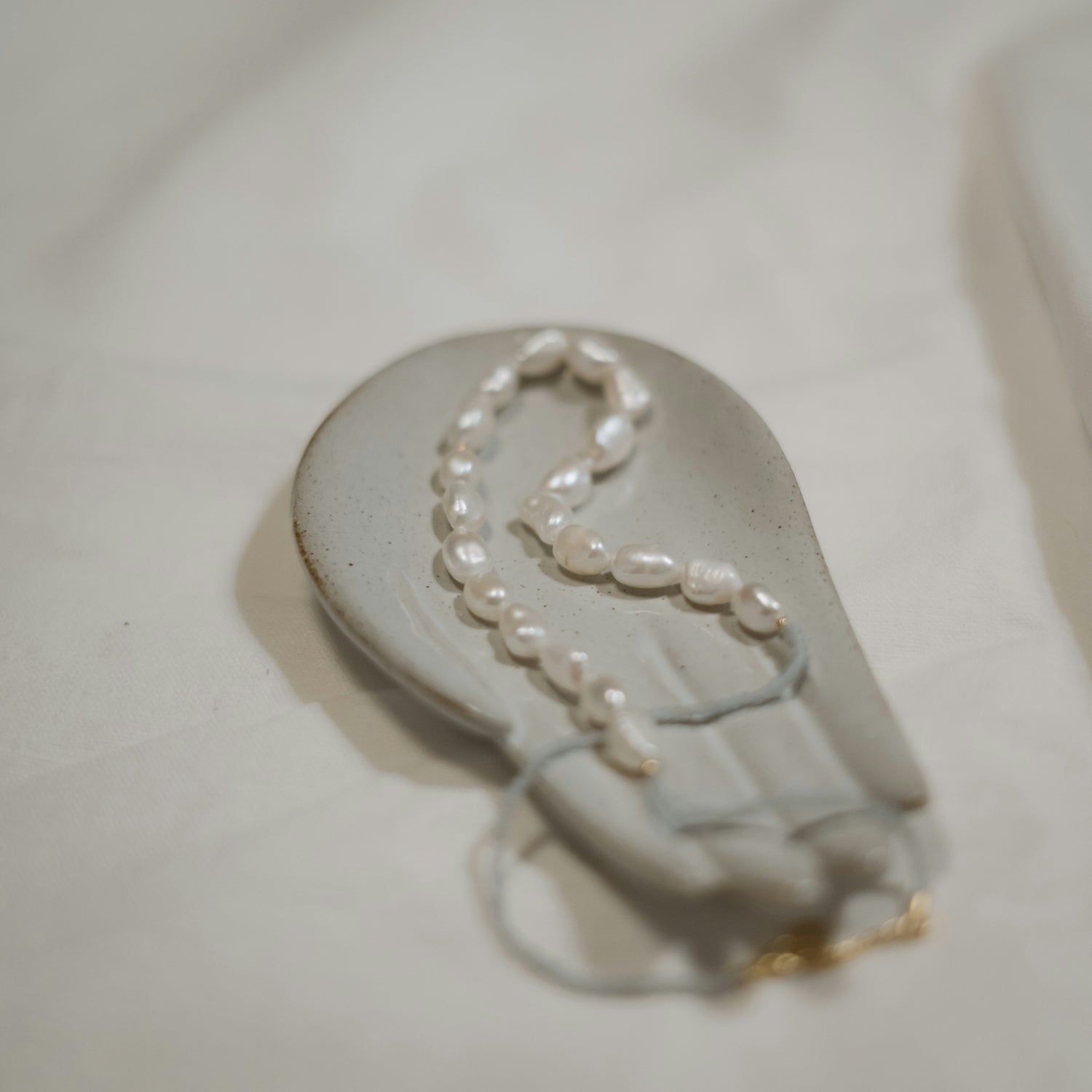Pearl Trivia
Pearls are mainly collected through two methods: natural excavation and artificial cultivation. It is a secretion produced by molluscs, such as oysters or mussels, when they open their shells to breathe. When sand particles or microorganisms in the sea enter the body, they are stimulated and feel uncomfortable to surround the intruders and protect them. itself. Over time, nacre develops into a smooth, lustrous pearl.
AKraft.852 uses real natural freshwater pearls instead of fake pearls or synthetic materials to ensure you the highest quality experience and a unique piece of jewelry.

Natural pearls/cultured pearls
Pearls can be divided into two types: natural pearls and cultured pearls. Natural pearls take a long time to grow and are formed under natural conditions. Only one wild pearl can be found in about 15,000 clams. Today, it is very rare and expensive.
Today, most of the pearls on the market are artificially cultured. Artificially cultured pearls are made by implanting a small bead core into mother-of-pearl through artificial intervention, simulating the natural production environment. Over time, multiple layers of proteins and natural minerals are covered on the bead core, making it easier to obtain and produce. , and the finished product is as crystal clear as natural pearls. Therefore, cultured pearls are not fake pearls, but real pearls just like natural pearls.
Freshwater Pearls vs Saltwater Pearls

Freshwater Pearls
The most commonly seen freshwater pearls refer to pearls formed in freshwater environments (rivers, lakes). Most of them are seedless culture technology. Because there is no nucleus (a shape that can be attached to grow), freshwater pearls can grow more freely. They usually show a variety of shapes and colors, such as round, semicircular, and oval. , irregular shapes, as well as white, pink, purple, gold, etc., with a softer luster.
A freshwater mother-of-pearl can have 10-60 pearls, and the number of perfect round pearls is relatively rare. Generally, out of 100 freshwater pearls, only 1 or 2 high-grade, perfect round pearls with jewelry value can be selected. The growth period of freshwater pearls is 1-2 years, and the growth environment is relatively stable, so they are relatively common and widely used in making jewelry. Their diversity and accessibility make the price more affordable.

Seawater Pearls
Also known as ocean pearls or South Sea pearls, most are nucleated and cultured, and the formation process is similar to freshwater pearls. However, due to different environmental conditions and composition in seawater, seawater pearls usually have a higher luster and a more rounded shape. In terms of production, on average, one fritillary can only produce 1-2 pearls, and the growth period lasts 3-5 years. Its scarcity makes it more expensive.

Baroque Pearls
Baroque pearls are a classification of pearls that generally refer to pearls that are non-round, irregular in shape, have obvious concave and convex textures on the surface and irregular luster that appear unexpectedly during the cultivation process. These pearls may come in a variety of colors, including white, pink, blue, yellow, green, and gray.
The term Baroque comes from an art style in the 17th century that emphasizes gorgeous, exaggerated and dramatic effects. Compared with traditional round pearls, Baroque pearls are more unique and personalized. Their unique appearance makes them widely used in jewelry design, making the works show unique personality and artistic sense.
Artificial Pearls vs Natural Pearls
Artificial pearls typically use glass, plastic, or other man-made materials to simulate the appearance of pearls. The common processing method is to use shell powder to compress into small beads, or use glass beads to imitate and then dye the pearls. The most common types of fake pearls are "glass pearls", "plastic pearls" and "shell pearls". Because they are artificially synthesized, the shape of artificial pearls must be round and perfect, without any surface defects, and the price is very low.
In contrast, natural pearls are pearls that form in their natural environment, usually from shells produced in nature. Their shape, color and luster may vary depending on the growing conditions and environment inside the shell. Natural pearls are more precious and rare than artificial pearls.
Quickly identify the authenticity of pearls
-
01 The cool touch of natural pearls
Natural pearls feel cool when in contact with the skin, while artificial pearls often have the same temperature sensation as their surroundings.
-
02 Pearl’s luster and light reflection
Natural pearls usually have a mild and soft luster, while artificial pearls may appear too smooth and reflect strong light.
-
03 Pearl shape and symmetry
Natural pearls may have slight variations in shape and symmetry, while artificial pearls usually have a very uniform shape and symmetry.
-
04 Surface quality of pearls
Natural pearls may have some texture, holes, or irregularities on their surface, while artificial pearls usually have a smoother and more flawless surface.
-
05 weight
Real pearls are usually heavier than fake pearls of the same size. This is because real pearls are composed of multiple layers of mother-of-pearl, while fake pearls are generally lighter due to their composition of synthetic or organic materials.
-
06 Surface inspection
Use a magnifying glass to carefully examine the surface of the pearl. Real pearls may have minor imperfections such as tiny blemishes, irregularities, or growth lines, which are signs of their natural formation. In comparison, fake pearls usually have a smoother, more perfect surface.
-
07 Drilling inspection
If you can look at a pearl that has been drilled, carefully inspect the holes. Real pearls usually have clean, smooth drill holes because they are naturally formed around a core. In contrast, fake pearls may have poorly drilled or irregular holes.
-
08 Friction method
If natural pearls rub together, you will feel a rough texture. If you rub them hard, some powder will fall off. If fake pearls rub against each other, they will only feel slippery and cannot feel the presence of pearl powder. However, real pearls are not afraid of friction, because after friction, as long as the powder is wiped off, the original luster will appear again.
-
09 price
Artificial pearls are generally less expensive, while natural pearls are more expensive.
-
-
-
Pearl care/wearing instructions
-
01.
Since chemicals and acidic substances will corrode the surface of pearls, it is recommended to avoid hairspray, perfume, and cosmetics from coming into contact with pearls and destroy their luster. It is best to wear pearl jewelry after applying makeup.
-
02.
Pearls occasionally need to be taken out for ventilation. It is recommended to store them in a flannel box independently and take them out for ventilation from time to time to prevent the pearls from turning yellow.
-
03.
Please avoid using too much force or putting pressure on the ornaments to avoid damage to the ornaments.
